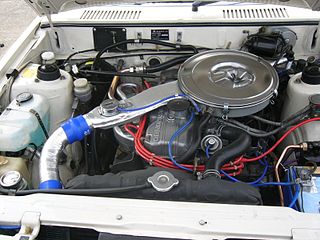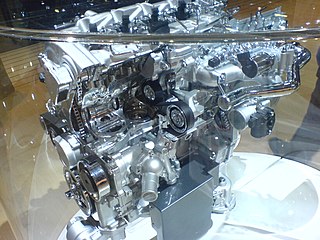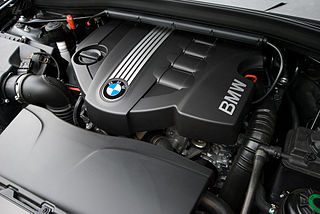
The Ford Duratorq engine, commonly referred to as Duratorq, is the marketing name of a range of Ford diesel engines introduced in 2000. The larger capacity 5-cylinder units use the Power Stroke branding when installed in North American-market vehicles. The first design, codenamed "Puma" during its development, replaced the older Endura-D unit which had been around since 1984. Commercial versions of the Puma unit replaced Ford's older "2.5Di" type unit used in the Transit, and many other manufacturers' vehicles - most notably the London Taxi and in the Land Rover Defender. Other unrelated units in this range have been developed by Ford and PSA. The TDCi Duratorq engines are available in vehicles from Ford, Jaguar, Land Rover, Volvo and Mazda. A new EcoBlue diesel engine range, originally codenamed "Panther" and planned to be available in 2.0- and 1.5-litre variants, will progressively replace the Duratorq engines from 2016.

The Toyota Avensis is a mid-size/large family car built in Derbyshire, United Kingdom by the Japanese automaker Toyota from October 1997 to August 2018. It was the direct successor to the European Carina E and was available as a four-door saloon, five-door liftback and estate.

Mazda has a long history of building its own diesel engines, with the exception of a few units that were built under license.

The Mitsubishi Astron or 4G5/4D5 engine, is a series of straight-four internal combustion engines first built by Mitsubishi Motors in 1972. Engine displacement ranged from 1.8 to 2.6 litres, making it one of the largest four-cylinder engines of its time.

The Toyota AZ engine family is a straight-4 piston engine series. The AZ series uses an aluminium engine block with cast iron cylinder liners and aluminium DOHC cylinder head. The engine series features many advanced technologies including slant-squish combustion chambers, offset cylinder and crank centers, and the VVT-i continuously variable intake valve timing system. The aluminium engine measures 626 mm (24.6 in) long, 608 mm (23.9 in) wide, and 681 mm (26.8 in) tall.
Multijet is a Fiat and General Motors joint venture, established in 1996, in manufacturing diesel engines with turbo and common rail direct injection technology. Most of the Fiat S.p.A., Fiat Professional, Groupe PSA, Alfa Romeo, Maserati, Lancia, Chrysler, Chevrolet, Daewoo Motors, Cadillac, Karsan, Temsa, Iveco, Jeep, Opel, Vauxhall Motors, RAM Trucks, Mitsubishi Fuso, Maruti Suzuki, Suzuki, Tata Motors and Saab Automobile branded vehicles are equipped with Multijet engines. Ownership of some Fiat Multijet designs is shared with General Motors as part of a settlement of the failed merger between the two auto conglomerates. The GM Powertrain Torino group in Turin, Italy, manages its interest in these engines. Some PSA Peugeot Citroën diesel engines are also rebadged JTD units, and vice versa. Fiat's common-rail diesel engine is also known as JTD, an initialism of UniJet Turbo Diesel.

The PSA EW/DW engine is a family of straight-4 black-top automobile engines manufactured by the PSA Group for use in their Peugeot and Citroën automobiles. The EW/DW family was introduced in 1998 as a replacement for the XU engine. Some DW engines are produced as part of a joint-venture with Ford Motor Company.

The DLD is the name for an automobile engine family – a group of compact inline-four Diesel engines, involving development by Ford of Britain and/or PSA Group, and also Mazda where it is called the MZ-CD or CiTD. The Ford of Britain/PSA and joint-venture for the production of the DLD/DV was announced in September 1998. Half of the total engine count are produced at Ford of Britain's main plant at Dagenham, England and at Ford's Chennai plant in India, the other half at PSA's Trémery plant in France.

The Toyota KZ is one of Toyota's small passenger diesel engines.

The Toyota KD engine series is a diesel engine produced by Toyota which appeared in 2000.

The Toyota Ipsum, Picnic, or Avensis Verso is a car produced by the Japanese carmaker Toyota from 1995 to 2010. It is a compact MPV with standard three-row seating. The Ipsum, like many Toyota products, was shared as a trio of the Toyota Gaia, and sold only at Japanese Toyota dealerships called Toyota Store, next to the Toyota Carina. The Gaia was unique to Toyopet Store locations, and the Toyota Nadia was sold at Toyota Corolla Store.
The Toyota ND is an inline-four diesel engine used for Toyota models in various markets including Japanese, Indian and European ones.
The Toyota B engine family was a series of inline-four diesel engines.
The Toyota H engine was first produced in 1967 but did not reach road cars until 1972. It is not a successor to the older and larger Toyota D engine.

The ZR engine is a family of straight-four 16-valve all-aluminum and water cooled gasoline engines with a die-cast aluminum block and variable valve timing developed by Toyota Motor Corporation, produced from 2007. Engines displace from 1.6 to 2.0 liters. Most engines in this family are equipped with Toyota's dual VVT-i technology that optimizes both intake and exhaust valve timing. This engine family is also the first to use Toyota's Valvematic system, first appearing on the Noah and Voxy in 2007 and then the European Avensis in 2009.

The Toyota AD engine family is a series of 16 valve DOHC inline-4 turbo diesel diesel engines with electronic common rail direct injection using an aluminium cylinder head and an aluminium cylinder block with cast iron liners derived from the petrol Toyota AZ engine. The AD engine is offered in 2.0 and 2.2 liter versions. These engines are produced mainly for Europe, but few are exported to other areas such as India or New Zealand.

BMW N47 is a four-cylinder common rail diesel engine that has many improvements over its predecessor, the M47. In 2014 it was replaced with the B47. The USA market never received B47 engine. The only B diesel engine in the US received was the B57 in the 2018 model 540d. The newest 4 cylinder diesel in the US was N47TU.
The Toyota CD engine is a 2.0 L (1,995 cc) diesel engine used in the Toyota Corolla, RAV4, Avensis and other vehicles. It is a DOHC engine with a bore and stroke of 82.2 mm × 94 mm with 116 hp (87 kW). The higher-output CD Series engines have now largely been replaced by the AD engine while low output applications were replaced by the ND engine.












